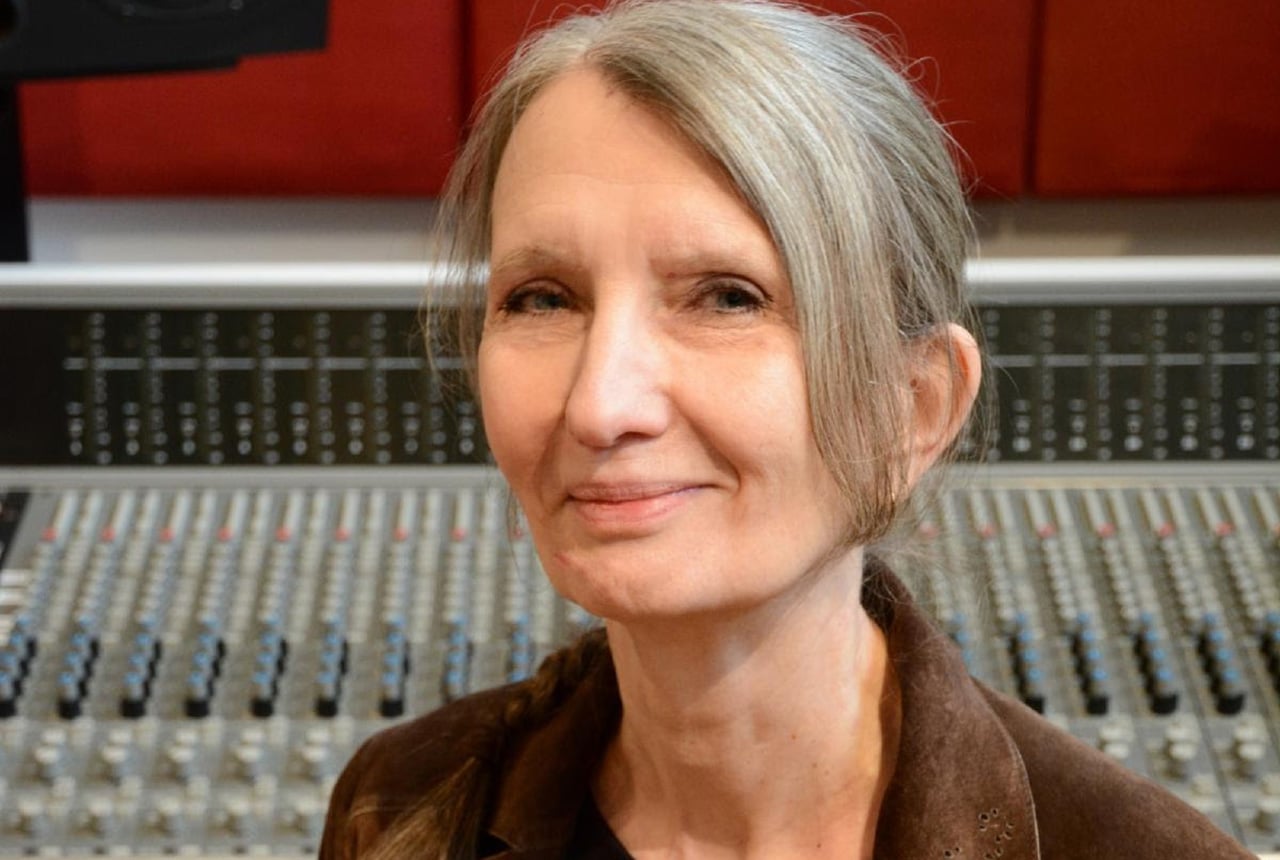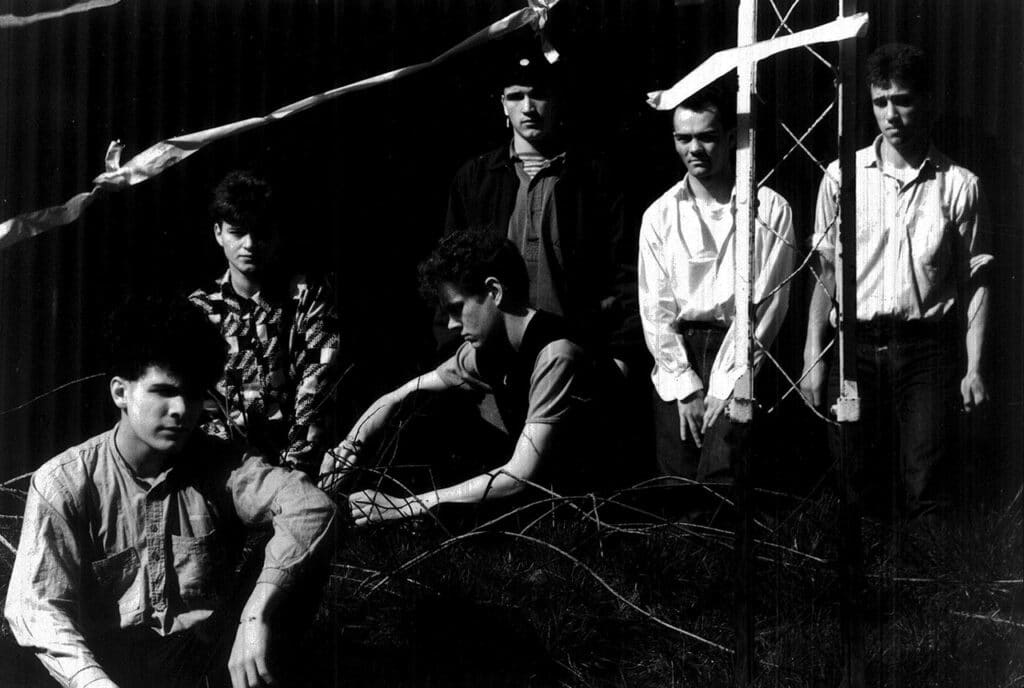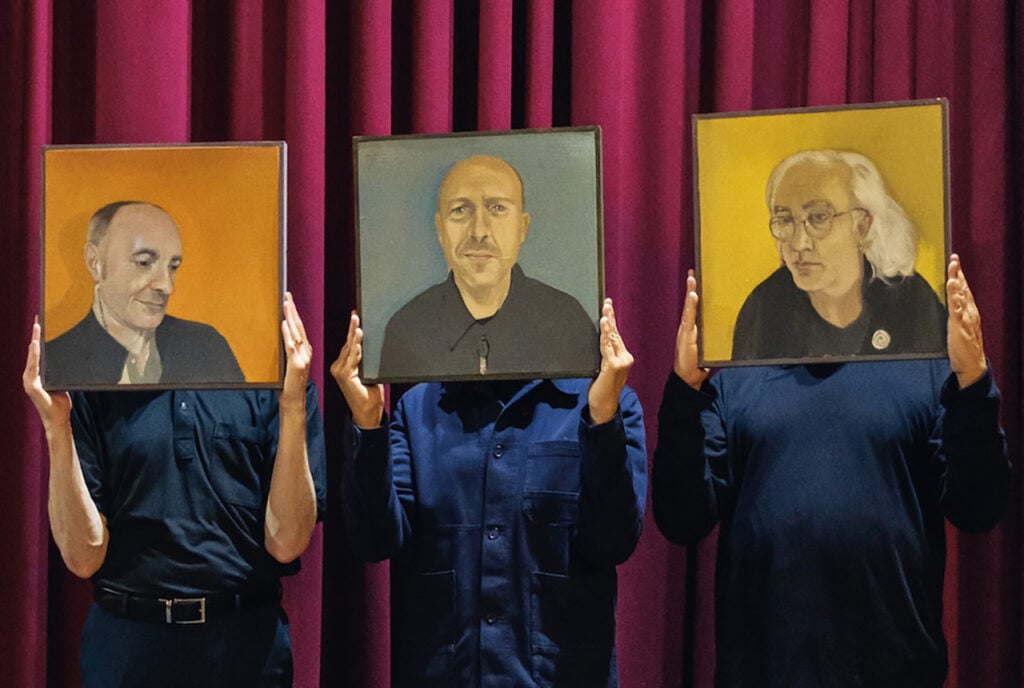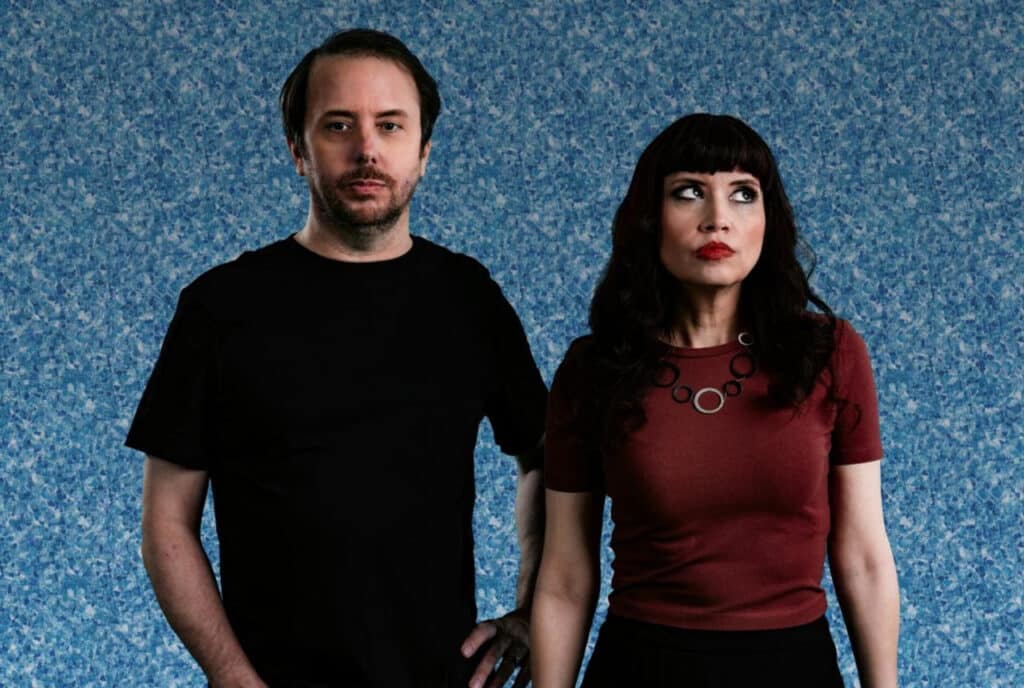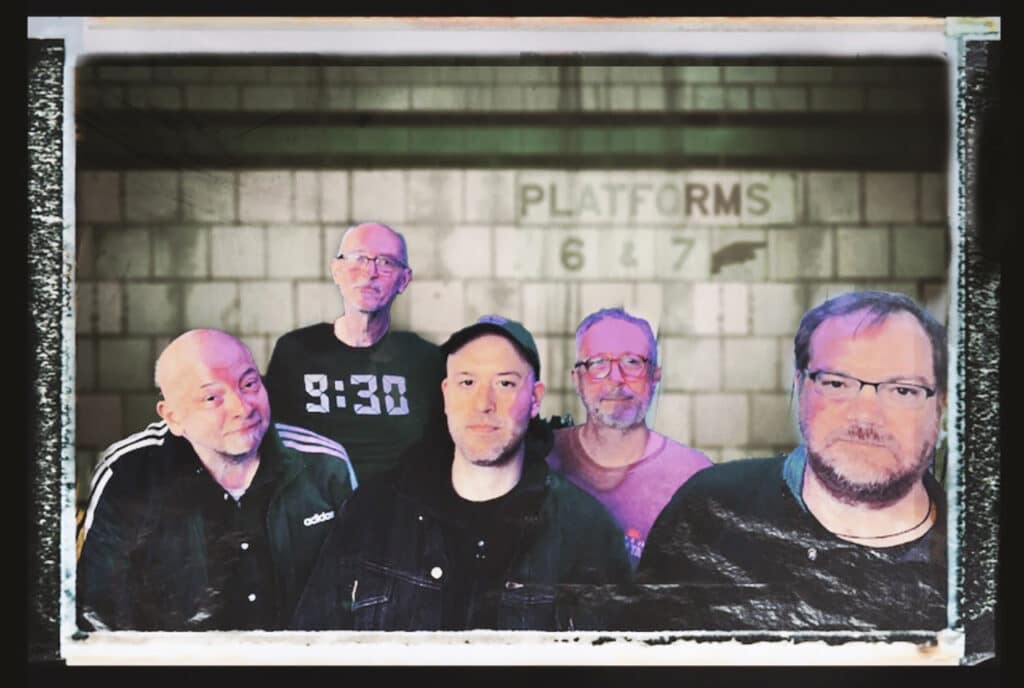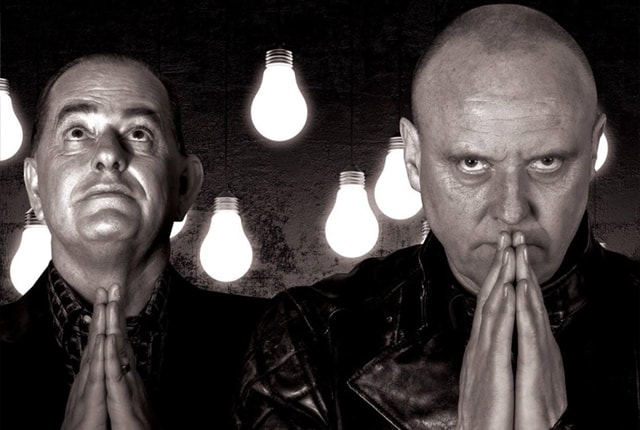As Karen Haglof prepared to follow up her 2019 album Tobiano, the world came to a halt, forcing her to pause and re-evaluate her creative process. Studios were closed, and the usual channels for collaboration disrupted. It forced her to embark on a journey of experimentation, incorporating loops, found sounds, and a more collaborative approach to her music. The resulting album, One Hand Up, showcases a blend of influences and a willingness to explore new directions that push the boundaries of her previous work.
The album also reflects her growing interest in visual storytelling. Videos are in the works for many of the tracks, and visual ideas inspired some songs. Haglof has a background in fine arts and, in recent years, has been learning and working with animation.
Haglof got her start in the Minneapolis indie rock scene before relocating to NYC, joining renowned avant-garde composer Rhys Chatham’s Ensemble and later Band of Susans. She moved away from music for many years, earning a medical degree and joining the hematology/oncology department of New York University Hospital, from which she retired in May 2023.
Over a Zoom interview, Haglof discussed her career and the making of One Hand Up.
Could you talk about the making of the new album? From what I read, you’d started work and interrupted by the pandemic? What effect did that have?
Karen Haglof: Yeah, it had a huge effect. I mean, the thing I’d put out before this was Tobiano, and that was in 2019. And so I was kind of thinking of putting out something in 2021, and we had the makings of a record. Then the pandemic hit in early 2020, and everything just went kablooey, basically. The studios weren’t open, and I couldn’t really send things down to mix with Mitch Easter because he wasn’t really open. And I ended up, when the studio finally opened, just kind of experimenting a lot with Mario Viele, who’s my co-producer and partner in crime on a lot of this. We started experimenting around with loops and things like that, found sounds I would just be recording as I’m walking down the street and just kind of going, ‘what if we try to do this or that or add to this?’
And then, I’ve worked with Charlie Roth for a long time. He’s a wonderful bassist, multi-instrumentalist, drums and keyboards and everything. And we would bring him to add his parts to the mix. I previously worked with Steve Almaas, as my producer on other records, and he got really busy with his own project that he was working on. And so, this was more of me kind of just going my own direction a little bit more. I’d also developed this interest in hand-drawn 2D animation, and I started to think about how these songs, or how any songs that I did, would translate to visuals. And I think that probably pushed a lot of things in certain directions. Not that you can really see it or anything, but in my mind, I was imagining what visuals would go with things. That might’ve pushed the direction of how we developed the sound on this. So that was a lot of it. The musical ecosystem just kind of disintegrated for a little while, and then it was put back together in a little bit of a different way, which ended up being a little bit looser in a lot of ways. I mean, just kind of using different aspects of my past or interests and kind of throwing them in there. And that I think is a different on this album compared with the others.
How far along were you in terms of the writing when the pandemic hit?
Karen Haglof: Let’s look. I have a copy here. Let me see. “Bus Driver,” for example. I wrote that song as I was waiting for the bus when the pandemic had an upsurge, and a lot of the bus drivers were out sick, and I’m waiting for the bus, and the bus did not come. I wrote that song walking to work. And so that was about 2022; that was later. “Girl vs Guitar” is something I’d been playing around with for a long time, just because I had this idea of a story of a girl who’s playing a guitar in a meadow and is stung by a bee and goes into a dream state and ends up flying in the sky with her friend who’s a bee, but in an alter-ego state. I think what was actually ready to mix for Mitch Easter at the time we did “Slinky 66” and “Day 34,” and “B.O.E.,” those three Mitch had done in 2020 or 2021. And then it was just getting too difficult. I was torturing Mitch with the back and forth. He’d send me a mix, and I’d be like, “Well, could we do this? Could we do that?” Not in real time, in that when you’re down there and you say, “Oh, can we just turn this knob a little?” and then you get an immediate result about what you want. That was just not possible now. So we tried a few with Mitch, and I think it was just too torturous for everyone involved. So Mario and I ended up mixing the rest of them. I have three songs that didn’t make it on this record that’ll come out later, that Mitch had also mixed, and maybe we’ll get back down to North Carolina again. He is a great person to work with. I mean, he added so much to the tracks that are here.
Did those songs not make it on because you didn’t have time or because they didn’t fit in?
Karen Haglof: They just didn’t feel like the right songs for this particular group. It felt like this particular group of songs were the ones that needed to come out. I think the songs are perfectly good. There’s no feeling like, ‘Oh, I don’t want to release that.’ It is just like, ‘Yeah, it doesn’t really fit in with this group.’ I would’ve put ‘em all out if I was going to do a double album, but that would’ve probably been too much.
There is quite a varied sound throughout the album. Was that an intentional thing you were going for? If so, did it cause any difficulty deciding what goes on it and maybe what the order and flow would be?
Karen Haglof: It was really hard to decide on the order and the flow. We were placing songs in one after the other, and the songs that didn’t make it on this record, it just kind of felt like, well, ‘This is a blues number and I already have enough stuff that’s kind of in that realm. Let’s save this. I’d love to put it out. Let’s just save this.’ So that kind of thing. But yeah, we went through a lot of different permutations trying to figure out what’s the best sequence for this, because they fit together in a way but not in a really obvious way to me. It’s a very idiosyncratic way, I think. And some of these songs came about because I was working in animation going, ‘Oh, let me do this little blurb for animation.’ And then all of a sudden I’d be like, ‘Oh, I know a song that would be good for this.’ And then developing a song based on my kind of early visual ideas that are not even completely finished yet. It was a little bit of a different process. I think I went into the studio a lot more frequently without a full song. In the last records, the demo would be pretty much set before going in. And here we were a lot looser in that let’s build … like ‘D.H.Y.B.’ was a weird riff in 13/8 time signature, which I didn’t even know until Charlie told me. But I’ve had this riff around for years and decided, ‘Let’s try and see if we can make a song out of that finally.’ And so, that was really a collaborative process in terms of coming up with the arrangement. And there was a lot more of that, I think, on this record than the prior ones. I guess for me, certainly a feeling like being a little less precious with how things are and going, ‘Yeah, you know what you’re doing, why don’t you do what you think is best?’ And I think that comes across. I mean, it’s all my songs but they’re all much more collaborative to me. I think we brought in a lot more elements than we have in the past.
Following up on the visual element, were there any particular songs where having those visual ideas may have changed your relationship to the material? Maybe shaped the song in terms of either musical ideas or production?
Karen Haglof: Yeah. Well, “Slinky 66” and the last track on there, “Rte 66 Revisited,” were just kind of built on the idea … for the last song, my nephew said, “I would like to have a song that would kind of go with a road trip.” And so we put together this kind of loop of what drummer Jonathan Kane had played on something else, and we never ended up using that. So we stole a drum track out of there and looped it to make the song. And then this is basically the idea of driving down a road, and I had an idea that this sounds like ending credits for something. So I had this whole visual of like, this is kind of a driving song that you’re seeing the ending credits of some movie. And so to me, it has a very cinematic feel. And I think having those visuals in mind pushed it in that direction.
We had lyrics on the song for a while and they just didn’t add. So we took them off, and it seemed a lot better. And for “Slinky 66,” Mitch put Moog on that, which just really makes the song, I think. And that was kind of the idea for the video for that. It was kind of a dreamy state of a couple driving, taking a beach trip. They’re driving down to Florida, on a state road, and hitting all the beaches along the East Coast. And it’s just kind of a dream state of times and places; they are in love and enjoying themselves. And so the visual of that drove the kind of dreamy qualities, I think, that we try to pull out of it.
How extensively will there be a visual component in the album? Are you going to have a video for each song?
Karen Haglof: I have partial videos for about seven songs now. And so the first one is out, ‘Slinky 66.’ And the next one that I have planned is ‘Day 34,’ and that’s about 70% done. I think I’ll try and get that out by the middle of July. And then there are about six or seven of them that have videos at least partially in the works, if not storyboarded out. So yeah, there’ll be videos going down the road. I mean, that was kind of the whole idea. I would’ve put them all out together except for I’m doing it all myself, and it was already taking long enough to get the music out without waiting for the art that I’m learning as I go. But to me, it adds another kind of fun aspect to putting music out so that people see, well, this is my vision too. This is what I’m thinking of when I’m working on this kind of material.
To what degree had you been doing visuals and video work prior to doing it for this album? What new techniques might you have used and learned for this?
Karen Haglof: Well, I was an art major back at University of Minnesota when I was like 17. And then I quit school to be in a rock band. I did some artwork for the restaurants I worked at. I would do the illustrations for menus or do the wall murals, that kind of thing. But nothing very extensive. And then I decided to go back to college in my thirties, and I went to Hunter College. I was an art major there, which was just all visual arts, mainly painting and drawing in large scale and pretty abstract. Then I went to medical school, and I did this whole pathway through medicine. And then about 2018 or 2019, I started to want to make animation. When I originally started putting music out, I had an idea I’d like to put four songs out with some video, and I didn’t think any further about it than that.
And then it turned into just making records instead of thinking about the visual aspect. But then with this, I started taking classes at the School of Visual Arts, which is in Manhattan, in their animation department and learning how to do 2D animation and working with some wonderful instructors, especially Martin Abrahams and Kat Llewellyn who are very well versed in all hand drawn 2D animation, as well as programs like After Effects and Photoshop. So I was kind of learning as I’m going when I’m putting these things together. And so those are the go-to programs that I’m using in this. And I’m trying to learn Harmony now, which is another one, a kind of industry standard for television cartoons and that kind of thing. It’s a very deep learning curve, but it’s a lot of fun.
It’s often mentioned how you shifted from music to a medical career. During that time, were you doing any songwriting at all? What was your relationship to music at that time?
Karen Haglof: It was not a relationship at all. The Band of Susans was the last group that I was playing in, in the late eighties and early nineties. And then I left to go back to college in 1992. Once I decided I wanted to try for medicine, I just kind of put my head down and said, ‘Okay, this is what I am really going to have to work at if I really want to do this.’ And so I really lost track of any of my friends or colleagues that were playing music and didn’t really pick my head up from the desk, so to speak, until about 2010 or so. That was after medical school and internship and residency and becoming an established attending physician affiliated with NYU in Manhattan. And then at that time, it was kind of like, ‘Okay, there probably needs to be some kind of fullness of life again.’
It was kind of like, ‘I’ve gotten where I think I want to go, but there are other things in life.’ And so I ended up seeing the movie, ‘It Might Get Loud,’ which you probably know of, [with] Jimmy Page and The Edge and Jack White. And when I saw it, it was like, ‘Oh, I’m a guitar player, I forgot.” I forgot I’m a guitar player. But seeing the old footage and hearing their stories and hearing them talk about it just really made me … it just kind of regrew my interest in doing it myself. And so I pulled out guitars. I didn’t think I’d play in a band again. So another interest I have is riding horses out west and at dude ranches, cowboy style, nothing fancy at all. And there’d often be campfires and cowboy singers playing songs at the campfire. And I thought that’d be a kind of fun thing to do, to just be able to pick up an acoustic guitar and just play a song.
And then I started to think it would be fun to do finger style and finger picking. So I started working in Open D tunings and tried to put together just kind of parlor guitar songs. There’s a standard called vestapol, which many people who do finger style will know. But from there, I started to put together riffs, and I thought that, well, some of these could be songs. I don’t think they’re songs yet that anybody else has done, but they could be songs. So I contacted Steve Almaas, who I’d been in a band called The Crackers with, and he was the bass player for the Suicide Commandos and had never left music, although he was doing other careers also, but he was very active in music. And I called him and kind of said, ‘I’ve got these beginnings of songs, would you be interested in helping me work on ‘em?’
And he was. So then the songwriting, I had the idea, ’okay, I’ve got these four things. Let’s do these four things in videos.’ He is like, ‘No, these are good. You can write an album. Why don’t you make an album?’ And so that’s how that all started. And that’s when I started actually writing lyrics. I had written one song before, back in 1979 or so with my friend Jan King, and we had a little band called The Wad, and we wrote a song called ‘Chains,’ which she did the lyrics and I did the music for, and it ended up on ‘Big Hits of Mid America Volume Three.’ So, it’s out there on that. And then it was covered by Soul Asylum, so it’s out there in that way, and her band covered it, and I’ve covered it. So, that was my one foray into the songwriting with some other projects with her back then that didn’t really see the light of day. But I’d always thought of myself more of a side person and not as the leader of anything or having my own project. So, it was a learning curve on that too, when to let go, when to say what you want, when to just let it learn. It’s a whole, everything is learning, which is what I like about life.
So now that the album is out, besides the videos, what are your other plans? Are you going to be touring at all?
Karen Haglof: Touring has never been a big part of my thing, mainly because I was an active hematologist and oncologist in practice, and it just was not practical to think that I could put out a record and then go away for two to three weeks, or even one week, and leave a very active patient base and keep a band together and all of that. So it was the one aspect that is highly underdeveloped for me. I mean, I’m not a live player, I just haven’t had the chances to do that. So I did retire last year from medicine, so it’s a possibility now. It seems like there’s actually some time that it might occur if anybody was interested.
And otherwise, we’re still in the studio. I got to finish those Mitch Easter songs from 2021. Those are good songs. Those have got to come out. They’re not going to just go away. The plan is to just keep working with the people that are around that I get to work with, because they are so wonderful. And you just don’t know what’s going to happen in the future.
Get One Hand Up and other music from Karen Haglof at karenhaglof.bandcamp.com.
